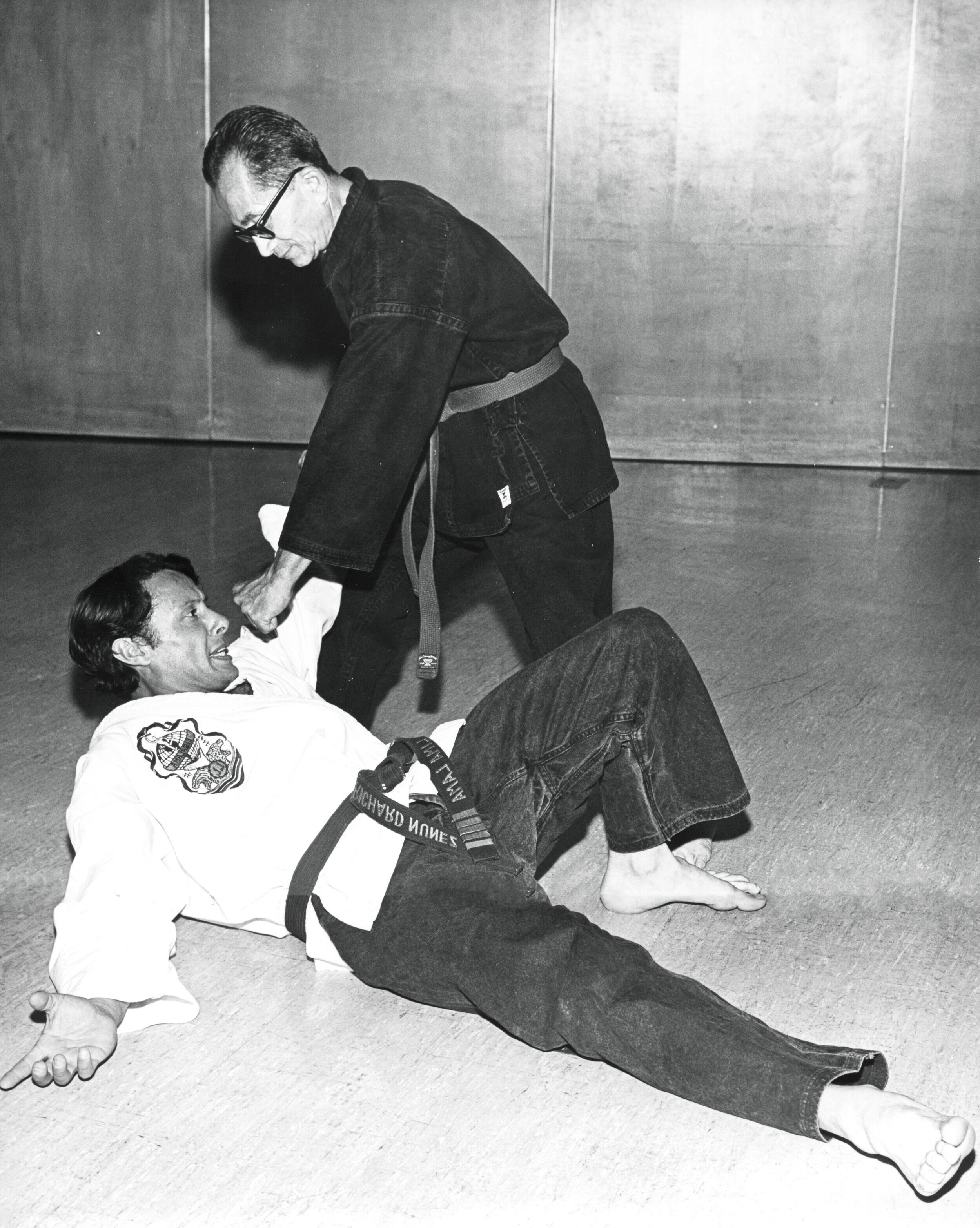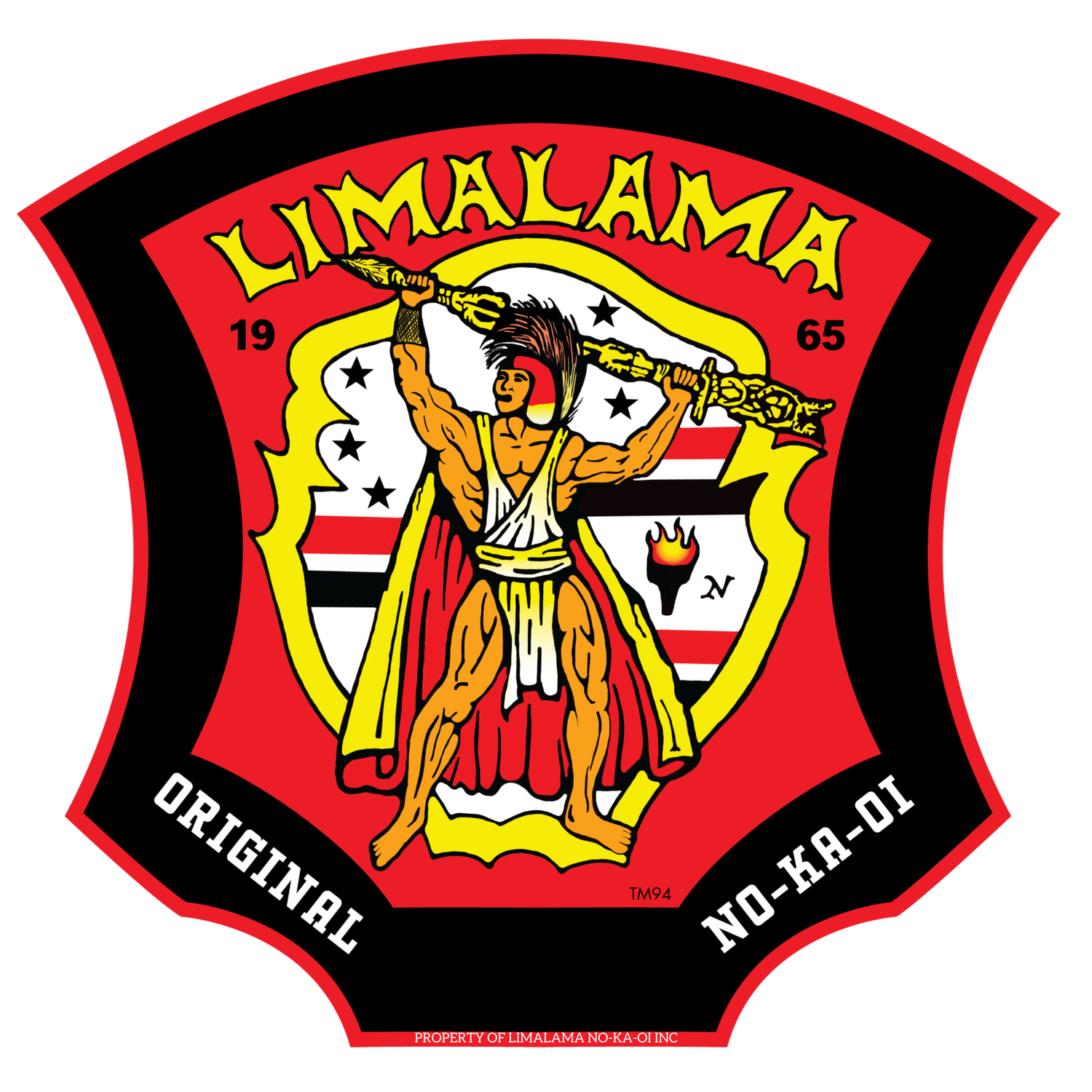
The Beginning of Limalama
The roots of Limalama trace back to the fighting system developed by the Grandmaster Tino Tuilosegas family in Samoa. His family once held a position of authority on one of the Samoan islands. Samoa and other South Pacific Islands residents were traditionally peaceful people who relied on farming and fishing for sustenance.
Ed Parker, Richard Nuñez and Tino Tuiolosega
In 1964, our Grandmaster Richard Nuñez encountered Tuumamao "Tino" Tuiolosega at Ed Parker's International Karate Championship. Mr. Nuñez was impressed by Tuiolosega's unique fighting style, which involved fast whipping hands and wrists. This style combined elements of Kung Fu, Kenpo, and Tuiolosega's own innovations. Richard approached Tino to learn his techniques, and after some convincing, they began training together. Eventually, other experts in martial arts, such as Haumea Tiny Lafiti, John Marolt, and Sol Kaikewalu, joined the training sessions, bringing their knowledge and expertise to the development of Limalama as a new self-defense system.
Limalama is a relatively small but growing martial arts system with approximately 65,000 practitioners. It emerged in the American martial arts scene in 1965, and some of its practitioners gained recognition through participation in Western U.S. tournaments.
As one of the highest-ranking Limalama masters, Richard, explained, "Because of the growing pains and political differences, most of the founding members of the Limalama Association either quit teaching or went their own way." Fortunately, this highly effective martial experienced a resurgence in popularity despite these challenges. Limalama spread across the western United States, Mexico, Latin America, and even Spain, with the largest concentration of Limalama practitioners believed to be in Mexico, followed by California & Hawaii.
1965 the formation of the first Black Belt Limalama Association with President Tino Tuiolosega, Vice-President Richard Nuñez, Sal Esquivel Secretary, Haumea, Tiny Lafiti and Sol Kaikewalu.
The founding members of Limalama brought with them martial arts techniques from other systems such as Kenpo Okinawa-Te, Lua, and Kung Fu, which were incorporated into Limalama, enhancing its effectiveness. However, due to the diversity among the original members and subsequent instructors, slight variations in Limalama techniques emerged from school to school. Nevertheless, despite these differences, an important observation is that students in training across different Limalama schools are both different and fundamentally the same.
While each school may have its unique interpretations and nuances, the underlying principles and core elements of Limalama remain consistent. This showcases the adaptability and flexibility of the system, allowing practitioners to express their individuality while staying true to the fundamental principles that define Limalama.
Tino Tuiolosega, Richard Nuñez and Fernando Chavez
Through the combination of various martial arts techniques from the founders and the incorporation of Tuiolosega's innovative hand movements, Limalama emerged as a distinct martial arts form that continues to attract practitioners and gain recognition. The initial training occurred in Tino's garage, away from the public eye. The focus was on fighting techniques and mastering the Polynesian flowing hands, executed with remarkable speed. The training sessions were intense and physically demanding, allowing the participants to develop the flowing whipping hand strikes.
Under Tino's guidance, the techniques evolved weekly without a set curriculum, presenting a challenge for the dedicated group of black belts. Despite the difficulties, they persevered, and after a year of training, Richard and the other men, along with Tino, decided to establish a new martial arts organization. The question of what to name the system arose.
Drawing from the languages of Samoan and Hawaiian, Tino and the Polynesian members of the group sought a common thread in the word "Lima," which translates to "five" or "hand" in both languages. To complete the system's name, they added "Malamalama," meaning "brilliant." However, considering the potential difficulty for non-Polynesian individuals to pronounce the full name, Tino proposed merging both worlds into the word "Limalama," defined by him as the "Hand of Wisdom."
The Birth of NO-KA-OI
After Richard Nuñez was approached by a former student named Fernando Chavez, expressing a desire for him to resume teaching, he initially declined. However, Fernando persisted and eventually became a close friend and confidant. Other former students also joined forces to convince Richard to return, highlighting the lack of Limalama schools in southern California and the opportunity for him to bring back the art in its true form. In 1991, Richard organized a seminar that over sixty former students attended, giving him a warm welcome back. This experience motivated Richard to establish his own extension of Limalama with his own style and curriculum. The creation of a new patch symbolized the beginning of Limalama, the Original NO-KA-OI, with a unique philosophy and approach to martial arts. Richard and his family were determined to move forward and never look back.
Meanwhile, Tino Tuiolesega, who had been living in Mexico for thirteen years, returned to the United States in 1991. Tino had promoted many black belt instructors during his time in Mexico, contributing to the spread of Limalama schools. However, these schools were not united under a single organization. Tino sought to bring Richard back into his Limalama organization, but Richard wanted to ensure that his curriculum would bear his name regardless of where he taught. While they did not continue together, they remained friends and maintained a cordial association.
Lonzie Johnson Jr, Eric Lee, Richard Nuñez, Teresa Nuñez, Sharon Nuñez
By 1992, Richard had established the organization's patch, developed a new curriculum, and witnessed successful participation in tournaments across the United States and Mexico. In 1995, NO-KA-OI was officially introduced to the world in Whittier, CA. Richard’s dedication and experimentation with various martial arts led to the creation of this new branch. The organization embodies values of honor, dignity, and respect for all races. His business acumen led to the expansion of schools and martial art merchandise. His vision was to see Limalama NO-KA-OI grow stronger and flourish globally as a self-defense art.
Here & Now
By 1999, NO-KA-OI rapidly expanded, and Richard continuously enhanced his fighting and self-defense techniques through trial and error. In that same year, he hosted a significant black belt promotion event, promoting over twenty black belts from first to sixth degree. During the event, Richard was also certified as the Grandmaster of Limamalama NO-KA-OI by the Grandmasters of the World Professional Black Belt Martial Art Organization, solidifying his reputation as a founder of the Limalama Association and a respected master of the arts.
During that time, a Mexican instructor named Fabricio Gomez from Tijuana sought Richard's mentorship. Recognizing Fabricio's potential as a valuable asset, Richard invited him into the Limalama No-ka-oi family. He tasked him with creating a new form of martial arts called Kickboxing Aerobics. In 1999, Fabricio had also earned the prestigious title of 9th-degree Black Belt in No-ka-oi, and his victory in the Grand Champion Black Belt Forms at the Internationals of Longbeach further expanded NO-KA-OI's influence in Mexico.
In August 2003, Richard received a platinum achievement award from WPBBMAO for his dedication to teaching martial arts. He always sought new ways to learn and improve, constantly expanding techniques, weapons, and advanced black belt forms, adapting to the changing times.
Martin Acala, Richard Nuñez, Fabricio Gomez and Sol Kaihewalu
Over the next 15 years, Richard continued to spread the knowledge of Limalama NO-KA-OI through teaching in the United States and supporting its expansion in Mexico through seminars, promotions, and tournaments. In 2015, at the age of eighty-three, he opened a new school within a fitness studio in uptown Whittier, attracting students of all ages and ranks with his vibrant and passionate instruction.
Although the passing of Senior Grandmaster Richard Nuñez in December 2021 was a significant loss, the time spent with him remains a cherished gift for all his students. His legacy lives on through his senior black belts, who continue to carry on his teachings and share the rich and flowing Polynesian movement with formidable power. Limalama NO-KA-OI is poised to thrive for generations to come, a tribute not only to Master Richard's lifelong contributions but also to the man himself, who overcame life's challenges to fulfill his dream for his family, the NO-KA-OI family, and future members.










